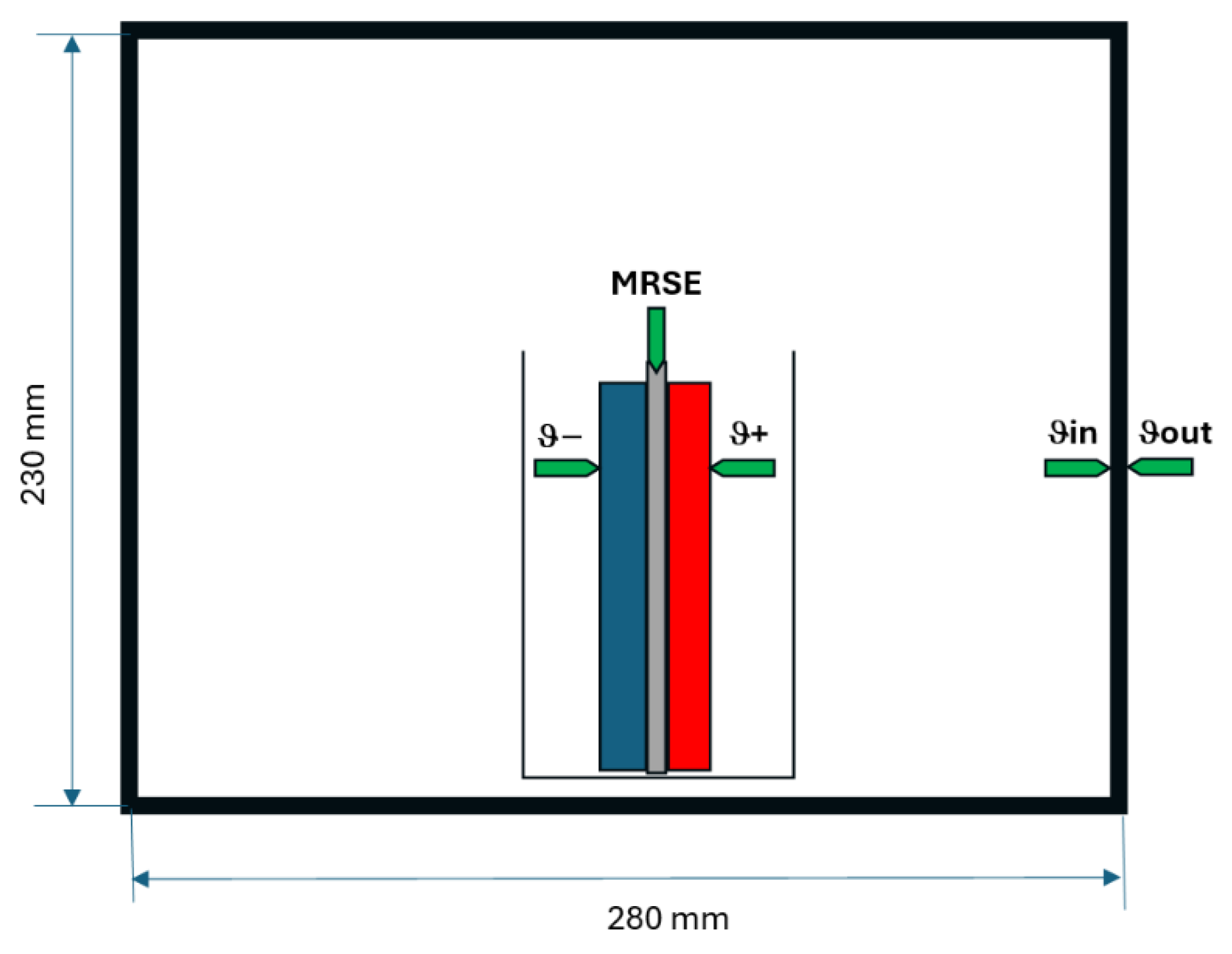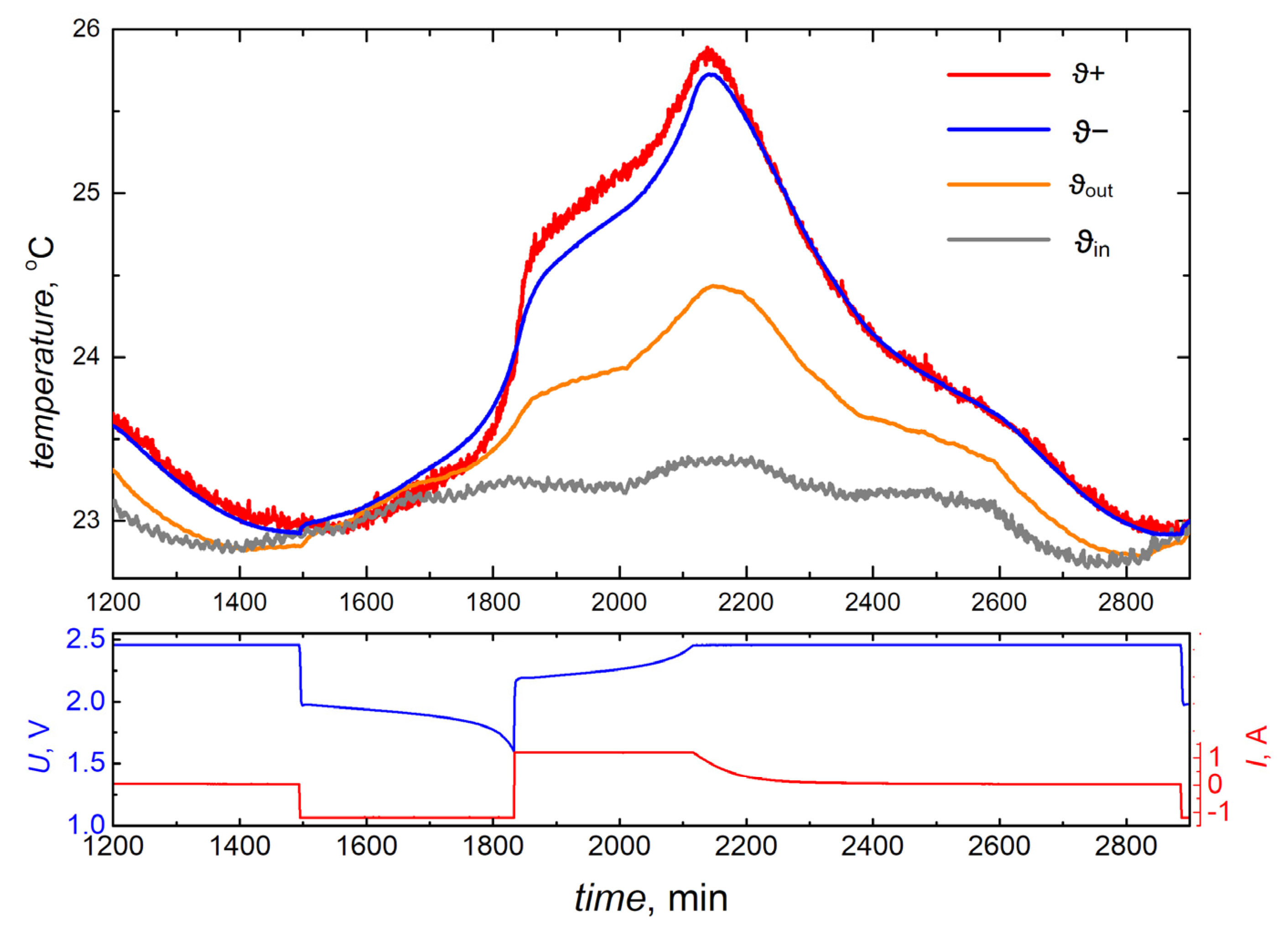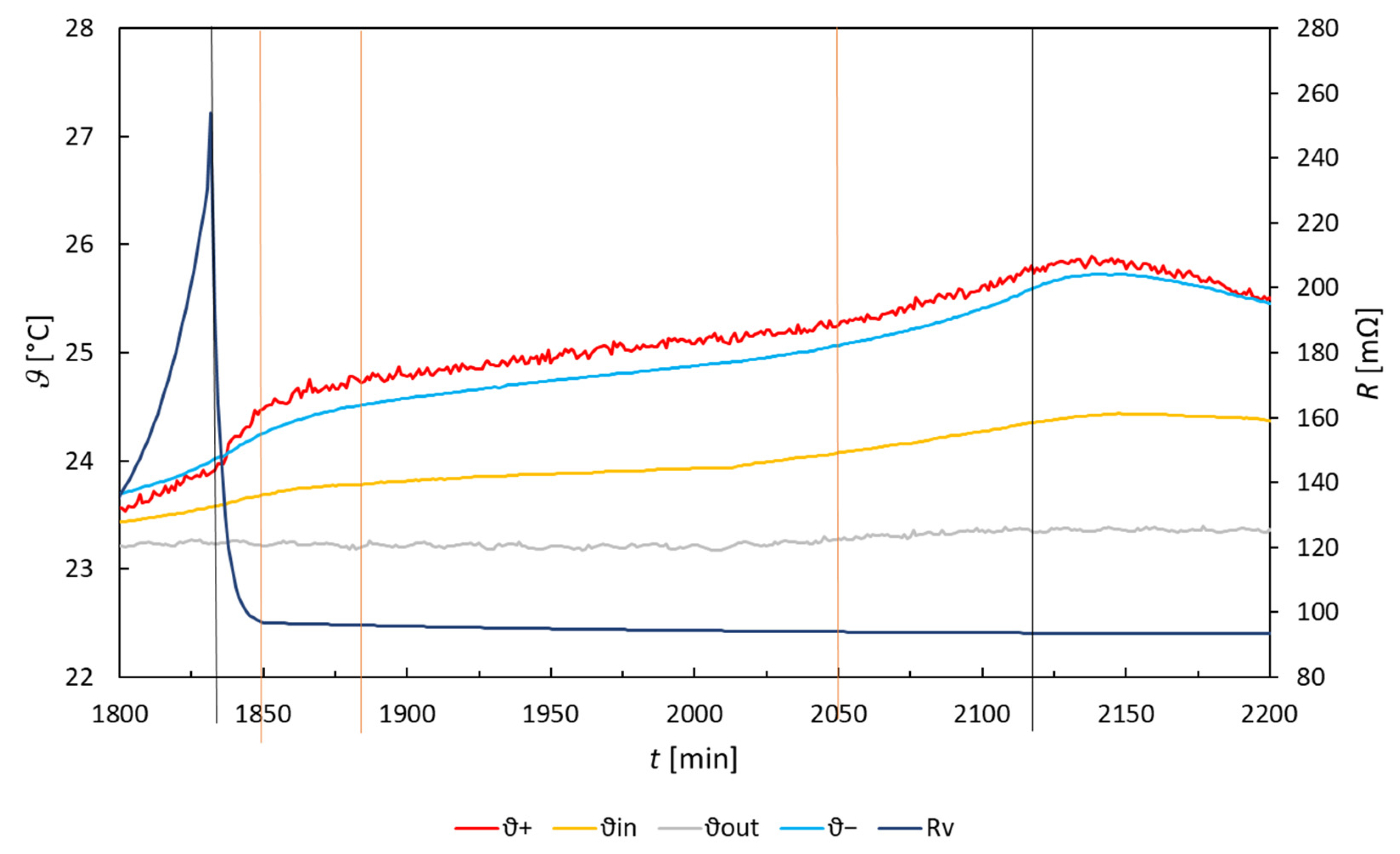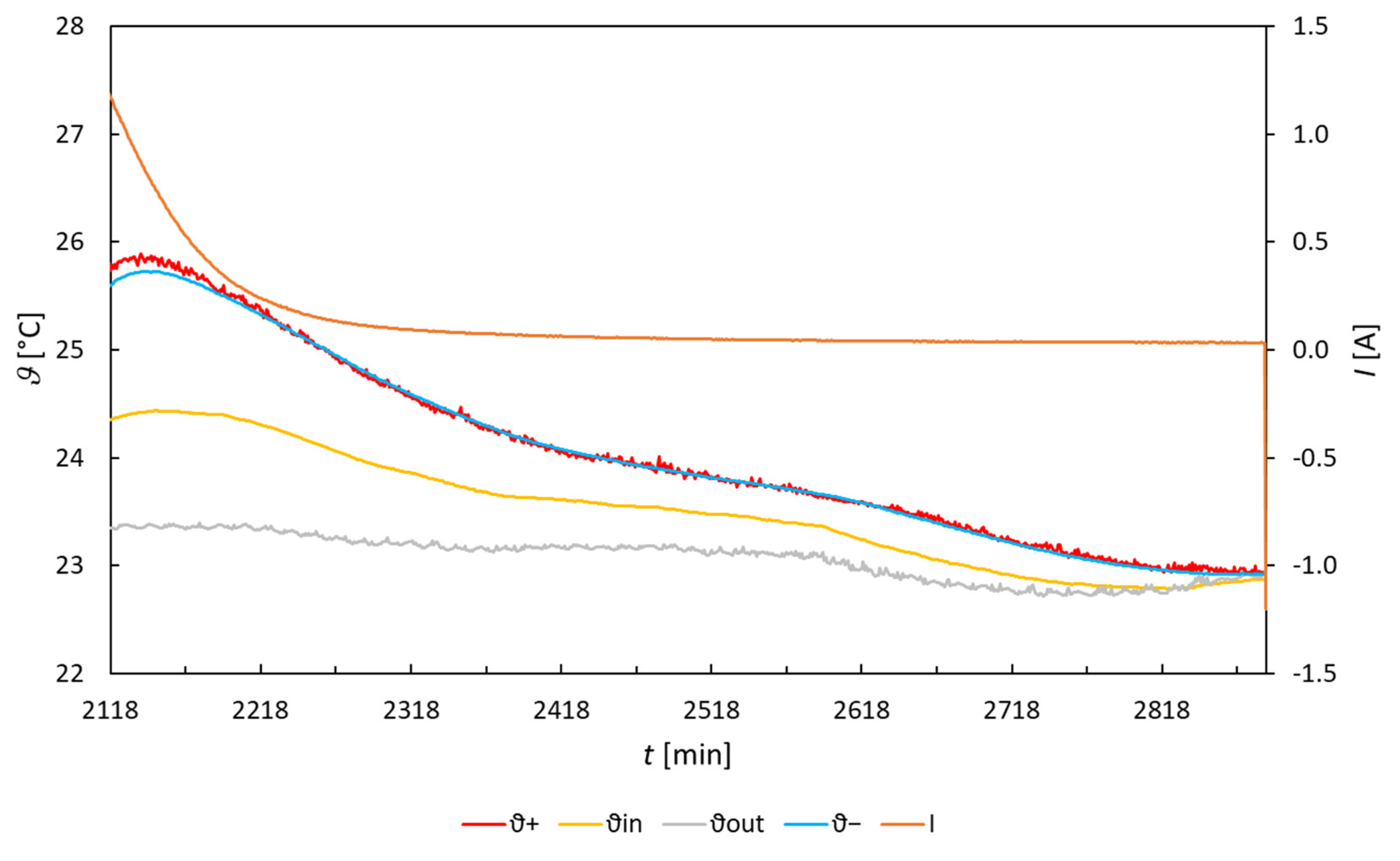Heat Effects during the Operation of Lead-Acid Batteries
Abstract
1. Introduction
2. Materials and Methods
2.1. Theoretical Foundation
2.2. Equipment and Materials Used
2.3. Measurement Methodology and Experimental Conditions
3. Results
3.1. Cycling of the Cell CC/CV
3.2. Discharging
3.3. Charging
4. Discussion
5. Conclusions
Author Contributions
Funding
Data Availability Statement
Conflicts of Interest
References
- Dimopoulou, S.; Oppermann, A.; Boggasch, E.; Rausch, A. A Markov Decision Process for managing a Hybrid Energy Storage System. J. Energy Storage 2018, 19, 160–169. [Google Scholar] [CrossRef]
- Mugyema, M.; Botha, C.D.; Kamper, M.J.; Wang, R.J.; Sebitosi, A.B. Levelised cost of storage comparison of energy storage systems for use in primary response application. J. Energy Storage 2023, 59, 106573. [Google Scholar] [CrossRef]
- Laaksonen, H. Improvement of Power System Frequency Stability with Universal Grid-Forming Battery Energy Storages. IEEE Access 2023, 11, 10826–10841. [Google Scholar] [CrossRef]
- Choi, D.; Shamim, N.; Crawford, A.; Huang, Q.; Vartanian, C.K.; Viswanathan, V.V.; Paiss, M.D.; Alam, M.J.E.; Reed, D.M.; Sprenkle, V.L. Li-ion battery technology for grid application. J. Power Sources 2021, 511, 230419. [Google Scholar] [CrossRef]
- Poullikkas, A. A comparative overview of large-scale battery systems for electricity storage. Renew. Sustain. Energy Rev. 2013, 27, 778–788. [Google Scholar] [CrossRef]
- Shamsi, S.S.M.; Barberis, S.; Maccarini, S.; Traverso, A. Large scale energy storage systems based on carbon dioxide thermal cycles: A critical review. Renew. Sustain. Energy Rev. 2024, 192, 114245. [Google Scholar] [CrossRef]
- Salem, M.H.; Mansouri, K.; Chauveau, E.; Ben Salem, Y.; Abdelkrim, M.N. Multi-Power System Electrical Source Fault Review. Energies 2024, 17, 1187. [Google Scholar] [CrossRef]
- Krishnamoorthy, M.; Periyanayagam, A.; Kumar, C.S.; Kumar, B.P.; Srinivasan, S.; Kathiravan, P. Optimal Sizing, Selection, and Techno-Economic Analysis of Battery Storage for PV/BG-Based Hybrid Rural Electrification System. IETE J. Res. 2022, 68, 4061–4076. [Google Scholar] [CrossRef]
- Dietz, A.; Hörlin, S.; Graß, N. High voltage Battery storage system for multiuse. In Proceedings of the 11th International Conference on Ecological Vehicles and Renewable Energies (EVER), Monte Carlo, Monaco, 6–8 April 2016. [Google Scholar]
- Wecel, D.; Jurczyk, M.; Uchman, W.; Skorek-Osikowska, A. Investigation on System for Renewable Electricity Storage in Small Scale Integrating Photovoltaics, Batteries, and Hydrogen Generator. Energies 2020, 13, 6039. [Google Scholar] [CrossRef]
- Oancea, C.D. Aspects of Renewable Energy Supply to Small Consumers. In Proceedings of the International Conference and Exposition on Electrical and Power Engineering (EPE), Iasi, Romania, 25–27 October 2012; pp. 964–967. [Google Scholar]
- Makola, C.S.; Le Roux, P.F.; Jordaan, J.A. Comparative Analysis of Lithium-Ion and Lead-Acid as Electrical Energy Storage Systems in a Grid-Tied Microgrid Application. Appl. Sci. 2023, 13, 3137. [Google Scholar] [CrossRef]
- Sajjad, M.; Zhang, J.; Zhang, S.; Zhou, J.; Mao, Z.; Chen, Z. Long-Life Lead-Carbon Batteries for Stationary Energy Storage Applications. Chem. Rec. 2024, 24, e202300315. [Google Scholar] [CrossRef]
- Wang, W.; Yuan, B.; Sun, Q.; Wennersten, R. Application of energy storage in integrated energy systems—A solution to fluctuation and uncertainty of renewable energy. J. Energy Storage 2022, 52, 104812. [Google Scholar] [CrossRef]
- Choi, K.W.; Yao, N.P. Heat Transfer in Lead-Acid Batteries Designed for Electric-Vehicle Propulsion Application. J. Electrochem. Soc. 1979, 126, 1321. [Google Scholar] [CrossRef]
- Torabi, F.; Esfahanian, V. Study of Thermal–Runaway in Batteries I. Theoretical Study and Formulation. J. Electrochem. Soc. 2011, 158, A850. [Google Scholar] [CrossRef]
- Torabi, F.; Esfahanian, V. Study of Thermal-Runaway in Batteries: II. The Main Sources of Heat Generation in Lead-Acid Batteries. J. Electrochem. Soc. 2013, 160, A223. [Google Scholar] [CrossRef]
- May, G.J.; Davidson, A.; Monahov, B. Lead batteries for utility energy storage: A review. J. Energy Storage 2018, 15, 145–157. [Google Scholar] [CrossRef]
- Khan, M.R.; Swierczynski, M.J.; Kær, S.K. Towards an ultimate battery thermal management system: A review. Batteries 2017, 3, 9. [Google Scholar] [CrossRef]
- Henke, M.; Hailu, G. Thermal Management of Stationary Battery Systems: A Literature Review. Energies 2020, 13, 4194. [Google Scholar] [CrossRef]
- Newman, J.; Tiedemann, W. Temperature Rise in a Battery Module with Constant Heat Generation. J. Electrochem. Soc. 1995, 142, 1054. [Google Scholar] [CrossRef]
- Cai, L.; White, R.E. Reduction of model order based on proper orthogonal decomposition for lithium-ion battery simulations. J. Electrochem. Soc. 2008, 156, A154. [Google Scholar] [CrossRef]
- Cai, L.; White, R.E. An efficient electrochemical–thermal model for a lithium-ion cell by using the proper orthogonal decomposition method. J. Electrochem. Soc. 2010, 157, A1188. [Google Scholar] [CrossRef]
- Ansari, A.B.; Esfahanian, V.; Torabi, F. Discharge, rest and charge simulation of lead-acid batteries using an efficient reduced order model based on proper orthogonal decomposition. Appl. Energy 2016, 173, 152–167. [Google Scholar] [CrossRef]
- Esfahanian, V.; Shahbazi, A.A.; Torabi, F. A real-time battery engine simulation tool (BEST) based on lumped model and reduced-order modes: Application to lead-acid battery. J. Energy Storage 2019, 24, 100780. [Google Scholar] [CrossRef]
- Ansari, A.B.; Esfahanian, V.; Torabi, F. Thermal-electrochemical simulation of lead-acid battery using reduced-order model based on proper orthogonal decomposition for real-time monitoring purposes. J. Energy Storage 2021, 44, 103491. [Google Scholar] [CrossRef]
- Broda, B.; Inzelt, G. Internal resistance and temperature change during over-discharge of lead-acid battery. J. Electrochem. Sci. Eng. 2018, 8, 129–139. [Google Scholar] [CrossRef]
- Křivík, P. Nové poznatky ve vývoji, výzkumu a optimalizaci olověných akumulátorů (New Findings in Research, Development And Optimization Of Lead-Acid Batteries). Věd. Sp. Vysok. Uč. Tech. V Brně Edice Habilitační Inaug. Sp. 2015, 495, 1–29. (In Czech) [Google Scholar]
- Křivík, P.; Vanýsek, P. Changes of temperature during pulse charging of lead acid battery cell in a flooded state. J. Energy Storage 2017, 14, 364–371. [Google Scholar] [CrossRef]
- Křivík, P. Temperature Changes of Lead Acid Battery Cell with Pulse Charging in a Flooded State. ECS Trans. 2016, 74, 123. [Google Scholar] [CrossRef]
- Křivík, P. Influence of the Oxygen Cycle on the Temperature of the Lead Acid Battery Cell. ECS Trans. 2014, 48, 273. [Google Scholar] [CrossRef]
- Kiehne, H.A. Battery Technology Handbook (Electrical & Computer Engineering), 2nd ed.; Kiehne, H.A., Ed.; CRC Press: Boca Raton, FL, USA, 2003; p. 542. [Google Scholar]
- Treptow, R.S. The Lead-Acid Battery: Its Voltage in Theory and in Practice. J. Chem. Educ. 2002, 79, 334. [Google Scholar] [CrossRef]
- NIST. NIST Chemistry WebBook. Available online: https://webbook.nist.gov/ (accessed on 13 January 2024).
- Pavlov, D. Energy balance of the closed oxygen cycle and processes causing thermal runaway in valve-regulated lead/acid batteries. J. Power Sources 1997, 64, 131–137. [Google Scholar] [CrossRef]
- Spingler, F.B.; Naumann, M.; Jossen, A. Capacity Recovery Effect in Commercial LiFePO4/Graphite Cells. J. Electrochem. Soc. 2020, 167, 040526. [Google Scholar] [CrossRef]
- Berndt, D. Electrochemical Energy Storage. In Battery Technology Handbook, 2nd ed.; Kiehne, H.A., Ed.; Marcel Dekker: New York, NY, USA, 2003. [Google Scholar]
- Berndt, D.; Spahrbier, D. Batteries, 1. General. In Ullmann’s Energy: Resources, Processes, Products; Elvers, B., Ed.; Wiley-VCH: Weinheim, Germany, 2015; Volume 1, pp. 3–25. [Google Scholar]
- Giauque, W.F.; Hornung, E.W.; Kunzler, J.E.; Rubin, T.R. The Thermodynamic Properties of Aqueous Sulfuric Acid Solutions and Hydrates from 15 to 300°K. J. Am. Chem. Soc. 1960, 82, 62–70. [Google Scholar] [CrossRef]
- Pavlov, D. Lead-Acid Batteries: Science and Technology–A Handbook of Lead-Acid Battery Technology and Its Influence on the Product, 2nd ed.; Elsevier: Amsterdam, The Netherlands, 2017; pp. 621–662. [Google Scholar]
- Hu, J.; Guo, Y.; Zhou, X. Thermal runaway of valve-regulated lead-acid batteries. J. Appl. Electrochem. 2006, 36, 1083–1089. [Google Scholar] [CrossRef]
- Calábek, M.; Micka, K.; Bača, P.; Křivák, P.; Šmarda, V. Analysis of positive-plate resistance during cycling and the effect of compression. J. Power Sources 1997, 67, 85–91. [Google Scholar] [CrossRef]
- Vinod, M.P.; Vijayamohanan, K. Effect of gelling on the impedance parameters of Pb/PbSO4 electrode in maintenance-free lead-acid batteries. J. Power Sources 2000, 89, 88–92. [Google Scholar] [CrossRef]
- Calábek, M.; Micka, K. Time effects in conductivity measurements of lead/acid battery electrodes. J. Power Sources 1990, 30, 309–314. [Google Scholar] [CrossRef]
- Micka, K.; Calábek, M.; Bača, P.; Křivák, P.; Lábus, R.; Bilko, R. Studies of doped negative valve-regulated lead-acid battery electrodes. J. Power Sources 2009, 191, 154–158. [Google Scholar] [CrossRef]






| Discharging | |||||||
|---|---|---|---|---|---|---|---|
| Interval | t | R | QJ | QR | Qcell | Qcal | Qz |
| min | mΩ | J | J | J | J | J | |
| 1 | 245 | 99.5 | 2106 | −1278 | 474 | 227 | 128 |
| 2 | 93 | 150 | 1205 | −485 | 545 | 129 | 99 |
| Charging | ||||||||||
|---|---|---|---|---|---|---|---|---|---|---|
| Interval | t | R | QJ | QR | Qcell | Qcal | Qz | Rpol | Qjpol | QRP |
| min | mΩ | J | J | J | J | J | mΩ | J | J | |
| 1 | 17 | 152 | 223 | 89 | 252 | 35 | 34 | |||
| 2 | 35 | 95 | 287 | 183 | 293 | 45 | 97 | |||
| 3 | 165 | 94 | 1340 | 861 | 555 | 144 | 615 | |||
| 4 | 67 | 93 | 538 | 349 | 566 | 144 | 314 | 46 | 265 | |
| 5 | 769 | 93 | 260 | 440 | −2819 | −718 | 1059 | >138 | 1003 | −1524 |
Disclaimer/Publisher’s Note: The statements, opinions and data contained in all publications are solely those of the individual author(s) and contributor(s) and not of MDPI and/or the editor(s). MDPI and/or the editor(s) disclaim responsibility for any injury to people or property resulting from any ideas, methods, instructions or products referred to in the content. |
© 2024 by the authors. Licensee MDPI, Basel, Switzerland. This article is an open access article distributed under the terms and conditions of the Creative Commons Attribution (CC BY) license (https://creativecommons.org/licenses/by/4.0/).
Share and Cite
Bača, P.; Vanýsek, P.; Langer, M.; Zimáková, J.; Chladil, L. Heat Effects during the Operation of Lead-Acid Batteries. Batteries 2024, 10, 148. https://doi.org/10.3390/batteries10050148
Bača P, Vanýsek P, Langer M, Zimáková J, Chladil L. Heat Effects during the Operation of Lead-Acid Batteries. Batteries. 2024; 10(5):148. https://doi.org/10.3390/batteries10050148
Chicago/Turabian StyleBača, Petr, Petr Vanýsek, Martin Langer, Jana Zimáková, and Ladislav Chladil. 2024. "Heat Effects during the Operation of Lead-Acid Batteries" Batteries 10, no. 5: 148. https://doi.org/10.3390/batteries10050148
APA StyleBača, P., Vanýsek, P., Langer, M., Zimáková, J., & Chladil, L. (2024). Heat Effects during the Operation of Lead-Acid Batteries. Batteries, 10(5), 148. https://doi.org/10.3390/batteries10050148







